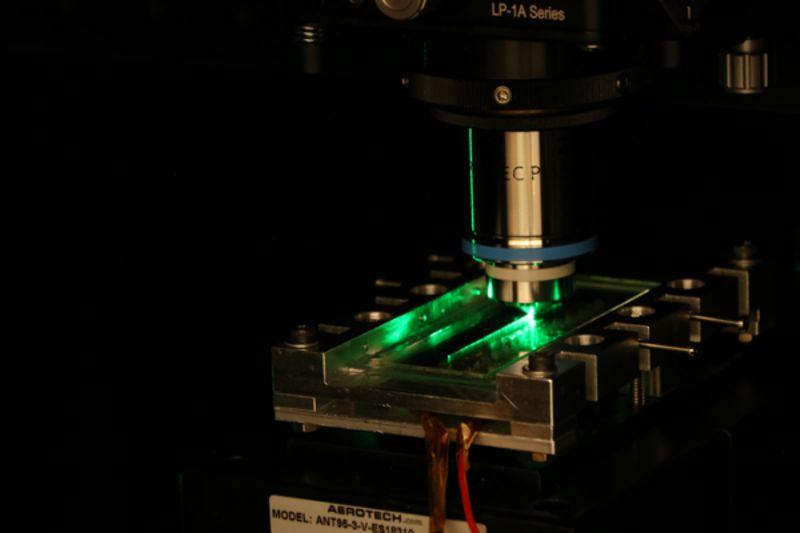Sapphire Optical Fibre could lead to Cleaner Energy and Air-Travel
27/04/22-FR-English-NL-footer
La fibre optique saphir pourrait conduire à une énergie et à des voyages aériens plus propres
 Sapphire optical fibre. Image by Julian Fells/University of Oxford
Sapphire optical fibre. Image by Julian Fells/University of Oxford
Les travaux, publiés dans la revue Optics Express, utilisent une fibre optique en saphir - un fil de saphir cultivé industriellement de moins d'un demi-millimètre d'épaisseur - qui peut résister à des températures supérieures à 2000°C.
Lorsque la lumière est injectée sur une extrémité de la fibre de saphir, une partie est réfléchie à partir d'un point le long de la fibre qui a été modifié pour être sensible à la température (connu sous le nom de réseau de Bragg). La longueur d'onde (couleur) de cette lumière réfléchie est une mesure de la température à ce point.
La recherche résout un problème vieux de 20 ans avec les capteurs existants qui, bien que la fibre de saphir semble très mince, par rapport à la longueur d'onde de la lumière, elle est énorme. Cela signifie que la lumière peut emprunter de nombreux chemins différents le long de la fibre de saphir, ce qui entraîne la réflexion simultanée de plusieurs longueurs d'onde différentes. Les chercheurs ont surmonté ce problème en inscrivant un canal sur toute la longueur de la fibre, de sorte que la lumière soit contenue dans une minuscule section transversale d'un centième de millimètre de diamètre. Avec cette approche, ils ont pu fabriquer un capteur reflétant principalement une seule longueur d'onde de lumière.
La démonstration initiale était sur une courte longueur de fibre de saphir de 1 cm de long, mais les chercheurs prédisent que des longueurs allant jusqu'à plusieurs mètres seront possibles, avec un certain nombre de capteurs séparés sur cette longueur. Cela permettrait par exemple d'effectuer des mesures de température dans l'ensemble d'un turboréacteur. L'utilisation de ces données pour adapter les conditions du moteur en vol a le potentiel de réduire considérablement les émissions d'oxyde d'azote et d'améliorer l'efficacité globale, réduisant ainsi l'impact environnemental. La résistance du saphir aux radiations donne également des applications dans les industries de l'énergie spatiale et de fusion.
Le Dr Mohan Wang, membre de l'équipe de recherche, du Département des sciences de l'ingénieur de l'Université d'Oxford, a déclaré: "Les capteurs sont fabriqués à l'aide d'un laser haute puissance avec des impulsions extrêmement courtes et un obstacle important empêchait le saphir de se fissurer pendant ce processus."
Le travail fait partie d'une bourse de recherche EPSRC de 1,2 M £ détenue par le Dr Julian Fells du Département des sciences de l'ingénieur de l'Université d'Oxford et a été réalisée en partenariat avec Rolls-Royce, l'Autorité britannique de l'énergie atomique (Remote Applications in Challenging Environments - RACE ), Université de Cranfield, Halliburton et MDA Space and Robotics.
Mark Jefferies, responsable de la liaison avec la recherche universitaire chez Rolls-Royce plc, a déclaré: «C'est une nouvelle passionnante et une autre réalisation scientifique importante résultant de notre partenariat de longue date avec l'Université d'Oxford. Cette recherche fondamentale pourrait à terme permettre une mesure de température multipoint plus efficace et plus précise dans des environnements difficiles, améliorant le contrôle, l'efficacité et la sécurité. Nous sommes impatients de travailler avec l'Université d'Oxford pour explorer son potentiel.
Rob Skilton, responsable de la recherche chez RACE, UK Atomic Energy Authority, a déclaré: «Ces fibres optiques en saphir auront de nombreuses applications potentielles différentes dans les environnements extrêmes d'une centrale à énergie de fusion. Cette technologie a le potentiel d'augmenter considérablement les capacités des futurs capteurs et systèmes de maintenance robotique dans ce secteur, aidant l'UKAEA dans sa mission de fournir au réseau une énergie de fusion sûre, durable et à faible émission de carbone.
Le Dr Fells, qui dirige la recherche, a déclaré: «Nous sommes très reconnaissants au UK Engineering and Physical Sciences Research Council (EPSRC) d'avoir soutenu ce travail et aux examinateurs qui ont vu le potentiel du travail stimulant que nous avons proposé. Nous travaillons maintenant avec nos partenaires pour développer davantage la technologie au point où elle peut être intégrée dans une infrastructure appropriée.
NJC.© Info University of Oxford
-----------------------------------------------------------------------------------------------------------------
27/04/22-English
Sapphire Optical Fiber could lead to Cleaner Energy and Air-Travel
 Sapphire optical fibre. Image by Julian Fells/University of Oxford
Sapphire optical fibre. Image by Julian Fells/University of Oxford
The work, published in the journal Optics Express, uses a sapphire optical fiber – a thread of industrially grown sapphire less than half a millimeter thick – which can withstand temperatures over 2000°C.
When light is injected onto one end of the sapphire fibre, some is reflected back from a point along the fiber which has been modified to be sensitive to temperature (known as a Bragg grating). The wavelength (colour) of this reflected light is a measure of the temperature at that point.
The research resolves a 20-year-old problem with existing sensors that, whilst the sapphire fiber seems very thin, in comparison to the wavelength of light it is huge. This means that the light can take many different paths along the sapphire fibre, which results in many different wavelengths being reflected at once. The researchers overcame this problem by writing a channel along the length of the fiber, such that the light is contained within a tiny cross-section, one-hundredth of a millimeter in diameter. With this approach, they were able to make a sensor reflecting a single wavelength of light.
The initial demonstration was on a short length of sapphire fiber 1 cm long, but the researchers predict that lengths of up to several meters will be possible, with a number of separate sensors along this length. This would enable temperature measurements to be made throughout a jet engine, for example. Using this data to adapt engine conditions in-flight has the potential to significantly reduce nitrogen oxide emissions and improve overall efficiency, reducing the environmental impact. The sapphire's resistance to radiation also gives applications in the space and fusion power industries.
Research team member Dr Mohan Wang, Department of Engineering Science, University of Oxford said: ‘The sensors are fabricated using a high-power laser with extremely short pulses and a significant hurdle was preventing the sapphire from cracking during this process.’
The work is part of a £1.2M EPSRC Fellowship Grant held by Dr Julian Fells at the University of Oxford's Department of Engineering Science and was carried out in partnership with Rolls-Royce, the UK Atomic Energy Authority (Remote Applications in Challenging Environments – RACE ), Cranfield University, Halliburton and MDA Space and Robotics.
Mark Jefferies, Chief of University Research Liaison at Rolls-Royce plc said: ‘This is exciting news and yet another important scientific achievement resulting from our long-standing partnership with Oxford University. This fundamental research could in time enable more efficient and accurate multi-point temperature measurement in harsh environments, improving control, efficiency, and safety. We look forward to working with the University of Oxford to explore its potential.’
Rob Skilton, Head of Research at RACE, UK Atomic Energy Authority said: ‘These sapphire optical fibers will have many different potential applications within the extreme environments of a fusion energy powerplant. This technology has the potential to significantly increase the capabilities of future sensor and robotic maintenance systems in this sector, helping UKAEA in its mission to deliver safe, sustainable, low carbon fusion power to the grid.’
Dr Fells, who is leading the research, said: ‘We are very grateful to the UK Engineering and Physical Sciences Research Council (EPSRC) for supporting this work and to the reviewers who saw the potential for the challenging work we proposed. We are now working with our partners to further develop the technology to the point where it can be integrated into suitable infrastructure.’
NJC.© Info University of Oxford
-----------------------------------------------------------------------------------------------------------------
27/04/22-NL
Sapphire Optical Fiber kan leiden tot schonere energie en luchtreizen
 Sapphire optical fibre. Image by Julian Fells/University of Oxford
Sapphire optical fibre. Image by Julian Fells/University of Oxford
Het werk, gepubliceerd in het tijdschrift Optics Express, maakt gebruik van een optische vezel van saffier - een draad van industrieel gekweekte saffier van minder dan een halve millimeter dik - die bestand is tegen temperaturen van meer dan 2000 ° C.
Wanneer licht op het ene uiteinde van de saffiervezel wordt geïnjecteerd, wordt een deel teruggekaatst vanaf een punt langs de vezel dat is aangepast om gevoelig te zijn voor temperatuur (bekend als een Bragg-rooster). De golflengte (kleur) van dit gereflecteerde licht is een maat voor de temperatuur op dat punt.
Het onderzoek lost een 20 jaar oud probleem op met bestaande sensoren die, hoewel de saffiervezel erg dun lijkt, in vergelijking met de golflengte van licht enorm is. Dit betekent dat het licht veel verschillende paden langs de saffiervezel kan nemen, waardoor er veel verschillende golflengten tegelijk worden gereflecteerd. De onderzoekers overwonnen dit probleem door een kanaal langs de lengte van de vezel te schrijven, zodat het licht zich in een minuscule doorsnede van een honderdste millimeter in diameter bevindt. Met deze aanpak waren ze in staat om een sensor te maken die voornamelijk een enkele golflengte van licht reflecteert.
De eerste demonstratie was op een korte lengte saffiervezel van 1 cm lang, maar de onderzoekers voorspellen dat lengtes tot enkele meters mogelijk zullen zijn, met een aantal afzonderlijke sensoren over deze lengte. Hierdoor zouden bijvoorbeeld temperatuurmetingen in een straalmotor kunnen worden gedaan. Het gebruik van deze gegevens om de motoromstandigheden tijdens de vlucht aan te passen, kan de uitstoot van stikstofoxide aanzienlijk verminderen en de algehele efficiëntie verbeteren, waardoor de impact op het milieu wordt verminderd. De weerstand van de saffier tegen straling geeft ook toepassingen in de ruimtevaart- en fusie-energie-industrie.
Onderzoeksteamlid Dr. Mohan Wang, Department of Engineering Science, University of Oxford zei: 'De sensoren zijn vervaardigd met behulp van een krachtige laser met extreem korte pulsen en een aanzienlijke hindernis verhinderde dat de saffier tijdens dit proces barstte.'
Het werk maakt deel uit van een EPSRC Fellowship Grant van £ 1,2 miljoen in het bezit van Dr. Julian Fells van het Department of Engineering Science van de Universiteit van Oxford en werd uitgevoerd in samenwerking met Rolls-Royce, de UK Atomic Energy Authority (Remote Applications in Challenging Environments - RACE ), Cranfield University, Halliburton en MDA Space and Robotics.
Mark Jefferies, Chief of University Research Liaison bij Rolls-Royce plc, zei: "Dit is opwindend nieuws en weer een belangrijke wetenschappelijke prestatie die het resultaat is van onze langdurige samenwerking met de universiteit van Oxford. Dit fundamentele onderzoek zou op termijn een efficiëntere en nauwkeurigere meerpuntstemperatuurmeting in ruwe omgevingen mogelijk kunnen maken, waardoor de controle, efficiëntie en veiligheid worden verbeterd. We kijken ernaar uit om samen te werken met de Universiteit van Oxford om het potentieel ervan te verkennen.'
Rob Skilton, Head of Research bij RACE, UK Atomic Energy Authority, zei: "Deze optische vezels van saffier zullen veel verschillende potentiële toepassingen hebben binnen de extreme omgevingen van een fusie-energiecentrale. Deze technologie heeft het potentieel om de mogelijkheden van toekomstige sensor- en robotonderhoudssystemen in deze sector aanzienlijk te vergroten, wat UKAEA helpt bij haar missie om veilige, duurzame, koolstofarme fusie-energie aan het net te leveren.'
Dr. Fells, die het onderzoek leidt, zei: 'We zijn de UK Engineering and Physical Sciences Research Council (EPSRC) erg dankbaar voor het ondersteunen van dit werk en de reviewers die het potentieel zagen voor het uitdagende werk dat we hebben voorgesteld. We werken nu samen met onze partners om de technologie verder te ontwikkelen tot het punt waarop deze kan worden geïntegreerd in een geschikte infrastructuur.'
NJC.© Info University of Oxford
-----------------------------------------------------------------------------------------------------------------
















